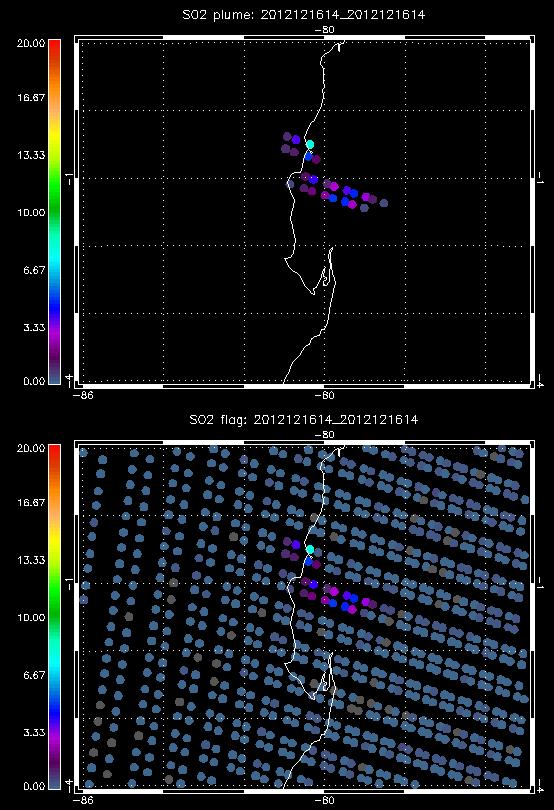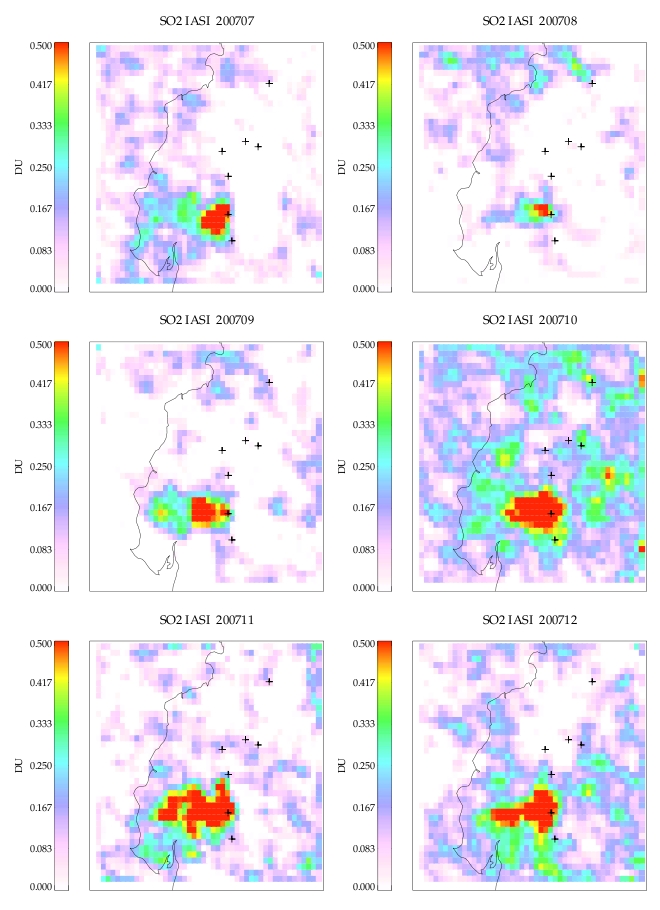Tungurahua: Difference between revisions
m (Blanked the page) |
No edit summary |
||
| Line 1: | Line 1: | ||
{{Infobox volcano | |||
| name = Tungurahua | |||
| elevation_m = 5,023 | |||
| lat_d = 1 | |||
| lat_m = 28 | |||
| lat_s = 1 | |||
| lat_NS = S | |||
| lon_d = 78 | |||
| lon_m = 26 | |||
| lon_s = 30 | |||
| lon_EW = W | |||
}} | |||
'''Tungurahua''' is an active volcano in Ecuador. | |||
[[File:Iasi ecua 200708 12.jpg|frame|center|IASI SO<sub>2</sub> monthly mean over Ecuador for the period July to December 2007. The retrieval assumed an SO<sub>2</sub> plume height of 600 mb. ''Credit: Dr Elisa Carboni'']] | |||
==Eruptions== | |||
===16 December 2012=== | |||
[[File:Plot flag v3 2012121614.jpg|frame|IASI SO<sub>2</sub> flag over Ecuador for the orbit of 16th Dec. 2012 14 UTC. | |||
The top plot shows the 'plume' pixels where the probability of SO<sub>2</sub> false detection is less than 1/10^5. | |||
The bottom plot show the SO<sub>2</sub> flag for all the IASI pixels (this shows the locations sampled by IASI for this overpass). | |||
''Credit: Dr Elisa Carboni'']] | |||
On 16 December the ash plume, generated by a large explosion, rose to a | |||
maximum height of 7 km and contained lightning. <ref>Smithsonian/USGS Volcanic Activity Report | |||
http://www.volcano.si.edu/reports/usgs/</ref> | |||
Other explosions generated ash plumes up to 2 km high. | |||
Satellite imagery showed ash plumes drifting 140 | |||
km NW, and 110 km NE at an altitude of 7.9 km a.s.l. The | |||
larger explosions during the morning were followed by pyroclastic flows that | |||
descended the SW and NW flanks. | |||
<ref>http://www.volcano.si.edu/world/volcano.cfm?vnum=1502-08=&volpage=weekly</ref> The Washington VAAC issued a volcanic ash alert at 13:00 UTC. | |||
<ref>Washington Volcanic Ash Advisory Center (VAAC) http://www.ssd.noaa.gov/VAAC/messages.html</ref> | |||
On 17 December satellite images showed ash plumes drifting 50-130 km NE, | |||
and a dense ash plume drifting over 200 km NE at an altitude of 7 km | |||
a.s.l. | |||
IG noted that explosions continued to generate ash plumes, but with progressively | |||
decreasing ash content. Ash plumes drifted NNE and NE, causing ashfall in | |||
communities downwind.<ref> Instituto Geofísico-Escuela Politécnica Nacional (IG) | |||
http://www.igepn.edu.ec/</ref> | |||
On 17 Dec. people living on the slopes of the Tungurahua volcano were evacuated.<ref>ABC News http://abcnews.go.com/International/wireStory/ecuadors-tungurahua-volcano-prompts-evacuations-17999286#.UNM8ctHCaHc</ref> | |||
<ref>BBC News http://www.bbc.co.uk/news/world-latin-america-20765920</ref> | |||
A fast look at the IASI data using our SO<sub>2</sub> detection flag<ref>A fast linear retrieval with a lot of assumptions, like the standard atmospheric profiles etc...</ref> | |||
shows enhanced levels of SO<sub>2</sub> above and to the NW of the volcano. <ref>Walker, J.C., E. Carboni, A. Dudhia and R.G. Grainger, Improved detection of sulphur dioxide in volcanic plumes using satellite-based hyperspectral infrared measurements: Application to the Eyjafjallajökull 2010 eruption, Journal of Geophysical Research, 117, D00U16, 2012.</ref> | |||
<ref> Walker, J.C., A. Dudhia and E. Carboni, An effective method for the detection of trace species demonstrated using the MetOp Infrared Atmospheric Sounding Interferometer, Atmospheric Measurement Techniques, 4, 1567—1580, 2011.</ref> | |||
==References== | |||
{{reflist|2}} | |||
[[Category:volcano]] | |||
Revision as of 11:01, 2 July 2013
| Tungurahua | |
|---|---|
| Elevation | 5,023 m |
| Latitude | 1° 28′ 1″ S |
| Longitude | 78° 26′ 30″ W |
Tungurahua is an active volcano in Ecuador.
Eruptions
16 December 2012

On 16 December the ash plume, generated by a large explosion, rose to a
maximum height of 7 km and contained lightning. [1]
Other explosions generated ash plumes up to 2 km high.
Satellite imagery showed ash plumes drifting 140
km NW, and 110 km NE at an altitude of 7.9 km a.s.l. The
larger explosions during the morning were followed by pyroclastic flows that
descended the SW and NW flanks.
[2] The Washington VAAC issued a volcanic ash alert at 13:00 UTC.
On 17 December satellite images showed ash plumes drifting 50-130 km NE,
and a dense ash plume drifting over 200 km NE at an altitude of 7 km
a.s.l.
IG noted that explosions continued to generate ash plumes, but with progressively
decreasing ash content. Ash plumes drifted NNE and NE, causing ashfall in
communities downwind.[4]
On 17 Dec. people living on the slopes of the Tungurahua volcano were evacuated.[5]
A fast look at the IASI data using our SO2 detection flag[7]
shows enhanced levels of SO2 above and to the NW of the volcano. [8]
References
- ↑ Smithsonian/USGS Volcanic Activity Report http://www.volcano.si.edu/reports/usgs/
- ↑ http://www.volcano.si.edu/world/volcano.cfm?vnum=1502-08=&volpage=weekly
- ↑ Washington Volcanic Ash Advisory Center (VAAC) http://www.ssd.noaa.gov/VAAC/messages.html
- ↑ Instituto Geofísico-Escuela Politécnica Nacional (IG) http://www.igepn.edu.ec/
- ↑ ABC News http://abcnews.go.com/International/wireStory/ecuadors-tungurahua-volcano-prompts-evacuations-17999286#.UNM8ctHCaHc
- ↑ BBC News http://www.bbc.co.uk/news/world-latin-america-20765920
- ↑ A fast linear retrieval with a lot of assumptions, like the standard atmospheric profiles etc...
- ↑ Walker, J.C., E. Carboni, A. Dudhia and R.G. Grainger, Improved detection of sulphur dioxide in volcanic plumes using satellite-based hyperspectral infrared measurements: Application to the Eyjafjallajökull 2010 eruption, Journal of Geophysical Research, 117, D00U16, 2012.
- ↑ Walker, J.C., A. Dudhia and E. Carboni, An effective method for the detection of trace species demonstrated using the MetOp Infrared Atmospheric Sounding Interferometer, Atmospheric Measurement Techniques, 4, 1567—1580, 2011.
